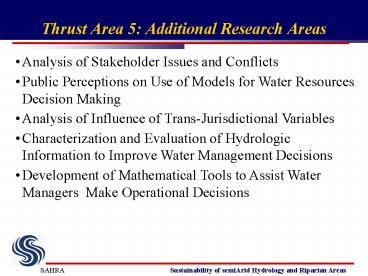Thrust Area 5: Additional Research Areas - PowerPoint PPT Presentation
1 / 17
Title:
Thrust Area 5: Additional Research Areas
Description:
Water allocation among competing interests and basin in overdraft. Growth management? ... Trends indicate increasing overdraft due to mining expansion and rapid ... – PowerPoint PPT presentation
Number of Views:172
Avg rating:3.0/5.0
Title: Thrust Area 5: Additional Research Areas
1
Thrust Area 5 Additional Research Areas
- Analysis of Stakeholder Issues and Conflicts
- Public Perceptions on Use of Models for Water
Resources Decision Making - Analysis of Influence of Trans-Jurisdictional
Variables - Characterization and Evaluation of Hydrologic
Information to Improve Water Management Decisions - Development of Mathematical Tools to Assist Water
Managers Make Operational Decisions
2
Case Studies
- Upper San Pedro
- Gila/Salt-Verde
- Middle Rio Grande
- Conchos
3
Analysis of Stakeholder Issues and Conflicts
Major Research Issues
- What are stakeholders perspectives on water
management, water policy, and water research
needs? - What is the feasibility and utility of combining
hydrologic models and alternative dispute
resolution scenarios to solve water resources
problems?
4
Analysis of Stakeholder Issues and Conflicts
Upper San Pedro
- Groundwater supply and demand in Mexico
- Growth and growth management in U.S.
- Legal and policy challenges and opportunities
Photo National Geographic
5
Upper San Pedro Stakeholders (US and Mexico)
- Federal resource management, research and
regulatory agencies SEMARNAT, CNA, CILA, IMTA,
CANABIO, INE, BLM, EPA, DOD, NPS, USFWS, USFS,
USGS, ARS - State Agencies IMADES, CoAPAES, SIUE, ADWR,
ADEQ, ADSL, NRDC - Local Governments Naco, Cananea, Cochise County,
Sierra Vista, Huachuca City, Benson, Tombstone - Researchers UNISON, COLSON, IMADES, SALSA, UA,
ASU, SCERP - Interest Groups Asociación de Agricultores de
San Pedro, Asociación de Ganadero de Cananea,
Asociación de Productores Rurales de Canaea,
Enlace Ecológico, Grupo Ecologista, Border
Ecology Project, San Pedro Alliance, San Pedro
100, Huachuca Audubon Society, Friends of the San
Pedro, The Nature Conservancy, Southeastern
Arizona Bird Observatory, People for the USA - Others Developer industries in the basin, e.g.,
Ft. Huachucha, Cananea mines residents of the
basin people who recreate in the basin
6
Analysis of Stakeholder Issues and
ConflictsFuture Activities
- Determine implications of recent and pending
water adjudication decisions in Arizona - Explore growth management options on U.S. side
and facilitate coordination among Mexican
stakeholders and Mexican environmental
initiatives - Focus on Native American water rights issues and
conflict resolution in Verde river basin
7
Public Perceptions on Use of Models for Water
Resources Decision Making
- Surveys carried out both at the San Pedro and the
Gila/Salt basins
- Groundwater hydrology in Mexican portion largely
unknown - Poor water delivery and poor water quality in
Mexican portion - Trends indicate increasing overdraft due to
mining expansion and rapid residential
development on border - Need for transparency and cooperation in policy,
research and management on border
- Water allocation among competing interests and
basin in overdraft - Growth management?
- Groundwater and surface water
- Careful allocation among competing users
- Geographic competition
- Value orientations
8
Analysis of Influence of Transjurisdictional
Variables
Research Issues
- Laws of many states have not kept pace with
advances in the science of hydrology - Many states have developed entirely separate
systems for regulating groundwater and surface
water - The consequences is a set of legal rules that
fail to conform to physical reality
9
Example Arizona Supreme Court Ruling
Arizona is one of those states. This has created
for the state two important legal questions
- Do Federal Reserve Water Rights Extend To
Groundwater That Is Not Subject To Prior
Appropriation Under State Law? - Are Federal Reserved Water Rights Holders
Entitled To Greater Protection From Groundwater
Pumping Than Are Water Users Who Hold Only State
Law Rights?
The Arizona Supreme Court has recently answered
YES to both questions
10
Arizona Supreme Court Ruling Implications
- Science Question
- What is the implication of these decisions to
- water users,
- water management institutions, and
- to the evolution of water law?
Although these are for Arizona the ruling has
broader implications in semi-arid regions in the
US
11
Characterization of Hydrologic Information to
Improve Water Management Decisions
Research Issue
- Lack of accurate, timely hydrologic information
is an impediment to improved water management
models and decisions
Examples
- Groundwater-surface water interaction in San
Pedro Basin - Groundwater-surface water interaction in
Gila/Salt-Verde - Drought characterization in Conchos River
12
Characterization of Hydrologic Information to
Improve Water Management Decisions Río Conchos,
Mexico
- 14 of Rio Grande/Bravo area
- 80 of Rio Grande/Bravo flows below Fort Quitman
- International Treaty (1944)
Annual Flows at Ojinaga
Mean Flow 812 Hm3/yr (658,300 acre-ft/yr) Mean
Precip. 380 mm/yr
13
Conchos River Basin Droughts
14
Conchos River Basin Drought-Area-Frequency
15
Research Questions Conchos River Basin
- Analyze alternative definitions of drought
temporal and spatial scales - Drought Prediction evaluate impact of climatic
precursors on forecast of droughts - Demand Characterization
16
Mathematical Tools to Assist Water Managers Make
Operational Decisions
Current and future activities
- Development of farms module for allocation of
irrigation water at district level - Development of stream water quality model for
Upper Rio Grande Water Operations Model (URGWOM) - Development of DSS for complex water resources
systems
17
Mathematical Tools to Assist Water Managers Make
Operational Decisions
- Main Objective
- Develop decision support systems (DSS) for the
management of complex water resources systems - Application
- San Pedro River Natural Conservation Area
(SPRNCA) - Issues
- Threats to wild-life, agency and users conflicts
Hydrologic Model
Water Quality Model
Optimization Model
Decision Makers
Reliability Analysis































